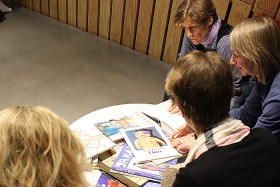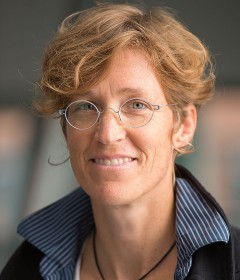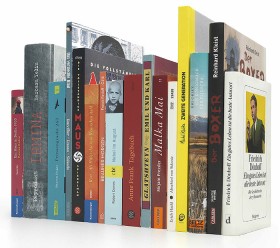An Interview with Barbara Rösch about “Recommended Reading on National Socialism and the Holocaust”
A German-language brochure listing “Recommended Reading on National Socialism and the Holocaust” was recently made available for download from our website as a PDF. Over the last few years several museum employees read widely on the topic, shared their opinions and then made this selection. Dr. Barbara Rösch of our Education Department talked to me about what was involved. She is a member of the reading circle and also worked for a time at the Universities of Potsdam and Leipzig as an elementary school teacher trainer. In addition to her work at the Jewish Museum Berlin she is currently writing a book about everyday racism in elementary schools.
Dear Barbara, countless books about National Socialism and the Holocaust are available for children and young people. How did you go about making a selection?
Our work is oriented primarily to the needs of teachers, who regularly ask us to make recommendations and indeed seem almost to think that we must. We therefore bear in mind the so-called “classics” that are read in German classrooms as well as new publications, books written from a non-German perspective, and books that touch upon hitherto neglected themes, such as the hakhshara movement. [Author’s note: hakhshara camps were where young Jewish people prepared for emigration to Palestine in the 1920s and 30s.]
We apply strict criteria when reading, with regard, for example, to the books’ historical accuracy, their literary quality, the insights they offer, and their suitability. In addition, we ask ourselves whether the story was patently written for an express didactic purpose (we hope it was not), whether the characters are convincingly drawn, whether the language and illustrations in the book are free of all forms of prejudice, stereotyping, and discrimination, and whether, on top of all that, the book is entertaining… to name just a few of our criteria. When a book read by at least three of us is found to meet all these criteria we are delighted.
Our discussion of individual books is always fascinating, serious, sometimes passionate, and controversial. It is also not yet over, since we continue to examine and expand our list.
To regularly read books about National Socialism and the Holocaust over such a long period can be extremely distressing. How did it affect you? Did you ever reach the point where you couldn’t read another word?
Given the sheer quantity of books to be read as well as the fact that we had to read each of them very attentively and assess it meticulously in the light of numerous criteria, pretty much every member of our reading circle needed to take a break at some point or other, or even recurrently—at the very latest, when the subject matter began stalking his or her dreams at night. Of course this was tied up also with each person’s family history.
In my particular case, it was the biography of Ernst Lossa, a Yenish boy who spent his childhood and youth in euthanasia centers, and was murdered in 1944 in the notorious Irsee “Mental and Nursing Institution” in the Allgäu in southern Germany. [Robert Domes: Nebel in August (Fog in August), cbt, 2008]
You recommend books for children aged 10+. How old should children be, before one talks to them about National Socialism and the Holocaust? Are some aspects of the topic a better means than others to first broach it? Can you recommend how, and when, parents and teachers might best go about introducing children to this topic?
If a child asks questions then the questions should be answered—but the accuracy and detail of one’s answers should take into account the individual child’s cognitive and emotional development. There are no “one-size-fits-all” or easily handled recommendations. Academic debate on the pros and cons of discussing National Socialism and the Shoah with primary school children has been ongoing since the 1990s but, despite a very unambiguous “pro” faction, many pedagogical issues have still to be clarified.
At the latest by the age of nine or ten children generally have extensive, or at least fragmentary knowledge of National Socialism and the Shoah. Research conducted in Germany by Andrea Becher shows that they tend to know about the structures of persecution and extermination but not about how the Shoah came about. Non-Jewish children continue on the whole to regard “Jews” as “the others” and as “non-German.” This is why it is vital to teach children and young people the methods necessary for specific historical research and to attempt to instill in them a sense of history.
A great number of teaching concepts have already been formulated for this field but no research has been done into their impact. Insofar as it’s possible to make explicit statements on curricula content and the pedagogical intent behind it, it seems that the topic of National Socialism is often dealt with in combination with the Shoah and not infrequently reduced to that aspect alone, generally in order to prompt a sense of moral concern.
Creating links with the reader’s own world is always a good way into the topic, and the main characters in literature for children and young people are therefore generally of a similar age to the target group. As a general rule, it is also well worth tackling the subject of perpetrators, as well as questions of corruptibility, submission, and the matter of resistance. It is likewise advisable to discuss Judaism and the diverse histories of Jews all over the globe—and by no means purely as an “introduction” to National Socialism and the Shoah.
What can books, for example the novels, graphic novels, and autobiographical texts compiled in this brochure, achieve in comparison with other forms of communication, such as general science, social studies, and history lessons, or museum programs?
I can lay a book or a comic aside then pick it up again weeks later, read it at my own pace, whenever I like, and let images surface in places and at times that suit me. I am not under supervision and am therefore initially free of the didactic-pedagogical intentions of my teachers… or [laughs] of museum educationalists.
In a short text on the last page of the brochure you emphatically list some books as “not-recommended.” Among them Friedrich, which is a classic; The Boy in the Striped Pyjamas, currently a very popular choice for the classroom; and The Book Thief, a bestseller. Precisely why you advise against choosing these books is explained in the brochure—but how come your group decided to make such a point of dismissing certain books rather than sticking solely with positive recommendations?
The books you name here are very well known among adult readers, and popular too. We therefore felt that to exclude them from the brochure would be read as an irritating oversight. Moreover, there is indeed much to be said about these books—but little to recommend, if one applies our criteria.
After discussing books that you don’t recommend I’d like to finish by asking which of the books in the brochure was your personal favorite?
The graphic novel Second Generation: Things I Never Told My Father (Dargaud, 2012) originally published in French by the artist Michel Kichka, who was born in Belgium in 1954.
Many thanks for the interview!
Mariette Franz, Digital & Publishing, was initially likewise a member of the reading circle but left, because in the long run she found the subject matter too distressing.
The PDF “Recommended Reading on National Socialism and the Holocaust” can be found on our German-language website.



Barbara, my grandmother (my mother’s mother) was born in Germany 1882 and passed 1933. My mother was 14 years of age. My grandmother’s mother passed in Germany. She is of the Roesch Family. She came to the U.S. with her father, elder sister and possibly twin brother. She was adopted out to the Barheite Family in Portland, New York. She passed with leukemia in a Infirmary I believe Freedonia or Portland, NY. It was in the infirmary my grandmoter (Lucy May Barheite) and my mother met my grandmother’s sister (first time for my mother) and YEARS later for my grandmother. My mother talked to her aunt and was told Roesch were German-Jews. When I came home from overseas 1969 my mother and I TRIED to research her mother’s family. We had to know Lucy’s father’s name. I written LANDESARCHIV BADEN-WURTTEMBERG and they needed Lucy’s father’s name. When I was TDY at Ramstein AB, I went to two ancestry’s and they needed the father’s name. I and my cousin are STILL reaching out to find out the true information on my grandmother and her family. I probably have you all twisted up…sorry. Wish I knew my great grandfather’s name and my great aunt’s name. It would be a miracle to find out info on our/my family. Thank you for just reading my Life’s Wish. Gott Segne.
“Beau”
WILLIAM E. BEAUJEAN, MSgt, USAF
General’s Aide de Camp/Ombudsman/Male Exec Secretary